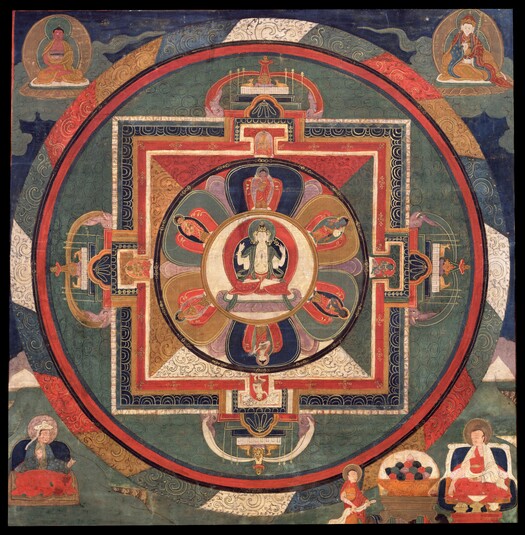
Item: Mandala of Avalokiteshvara (Bodhisattva & Buddhist Deity) - Chaturbhuja (4 hands)
| Origin Location | Tibet |
|---|---|
| Date Range | 1700 - 1799 |
| Lineages | Nyingma |
| Size | 40.64x40.01cm (16x15.75in) |
| Material | Ground Mineral Pigment on Cotton |
| Collection | Rubin Museum of Art |
| Catalogue # | acc.# P1996.16.5 |
Alternate Names: Lokeshvara Avalokita Lokanata Lokanatha Mahakarunika
Classification: Deity
Appearance: Peaceful
Gender: Male
Chaturbhuja Avalokiteshvara Mandala (Tibetan: chen re zi chag shi pa'i kyil khor. English: the Mandala of the Four-armed All Seeing Lord): surrounded by the Buddhas of the Six Realms of existence and the four female door guardians. In the Mahayana Buddhist tradition Avalokiteshvara is regarded as a bodhisattva that exemplifies compassion. In Vajrayana Buddhism there are many forms of Avalokiteshvara, both peaceful and wrathful, where he is a meditational deity and regarded as a completely enlightened Buddha.
Centrally located, peaceful in appearance, white in colour, with one face and four hands, the first pair are clasped at the heart holding a wishing jewel. The right hand upraised holds a white prayer bead mala and the left a lotus flower. Adorned with a crown of gold and jewels, necklaces, bracelets and anklets, he wears a green scarf across the shoulders and a red lower garment. The legs are folded together in vajra posture atop a moon disc and purple lotus flower surrounded by a blue-red nimbus and green aureola.
"To the Lord unstained by faults, white in colour, the head adorned with the perfect buddha, gazing on beings with eyes of compassion; to Avalokiteshvara I bow." (The verse is attributed to the Tibetan King Songtsen Gampo, 557-649).
Surrounding the central figure, on the six petals of the lotus are the six Buddhas of the six realms of cyclic existence - Shakyamuni, Indra, Thag Zangri, Shakya Simha, Namka Dzo and Dharma Raja. In the general appearance of a buddha, they each hold their own objects, wear red and yellow robes and stand tall with the legs together. Outside of that is a ring of gold vajras on a blue background. The inner courtyard of the palace mandala is divided into 4 colours, white in the east, yellow for the south, red - west and north - green. The square enclosure represents the 4 walls and the 'T' shaped structures on each side the 4 doors. Above are 4 coloured steps, a Dharma wheel, two deer and a small canopy. Seated at the door entrances are the 4 female Door Guardians, Vajrankushi, Vajrapashi, Vajrasphota and Vajraghanta. A ring of pristine awareness fire in five colours surrounds the mandala.
At the top left is the Buddha Amitabha, red, with the hands placed in the lap in the mudra of meditation. At the right side is Guru Rinpoche Padmasambhava holding a vajra and skullcup, richly attired and wearing the lotus hat. At the bottom left a seated male figure performs various gestures with the hands, regally attired with a white head covering, green and red robes, atop a cushion seat. At the right side a lama figure wears the white upper robe of a yogi, a red meditation belt and a lower robe. In front a small table supports a central teacup on a gold platform. At the side a table of offerings is prepared with heaped wishing jewels in a large golden bowl. On the ground below that lay various coloured bolts of cloth. A solitary monk stands at the side holding an unfurled white scarf.
Avalokiteshvara is foremost a bodhisattva arising from the sutra tradition and secondly a tutelary deity of the Vajrayana tradition. He is represented in all 4 tantra classifications in a variety of forms, singular, complex mandalas, with a consort and wrathful in appearance.
Jeff Watt 9-99
Publication: Himalayan Buddhist Art 101: Tricycle Magazine Blog Posts (Chronological List)
Thematic Sets
Buddhist Deity: Avalokiteshvara Iconography
Bibliography: Mandala
Mandala: Mandala Main Page
Collection of Rubin Museum of Art: Painting Gallery 7
Tradition: Nyingma Deity Paintings
Mandala: Geometric Shaped Mandalas
Mandala: Inverted-figure Mandala
Buddhist Deity: Avalokiteshvara Main Page
Mandalas: Nyingma Tradition
Subject: Iconographic Bodhisattva
Buddhist Deity: Avalokiteshvara, Chaturbhuja - Four Hands - Main Page
Buddhist Deity: Avalokiteshvara & Amoghapasha (All Mandalas)
Mandala: Shape, Form & Composition
Buddhist Deity: Avalokiteshvara, Chaturbhuja (Without a Krishnasara)
Collection of Rubin Museum of Art: Mandala
Collection of Rubin Museum of Art: Avalokita (Painting)
